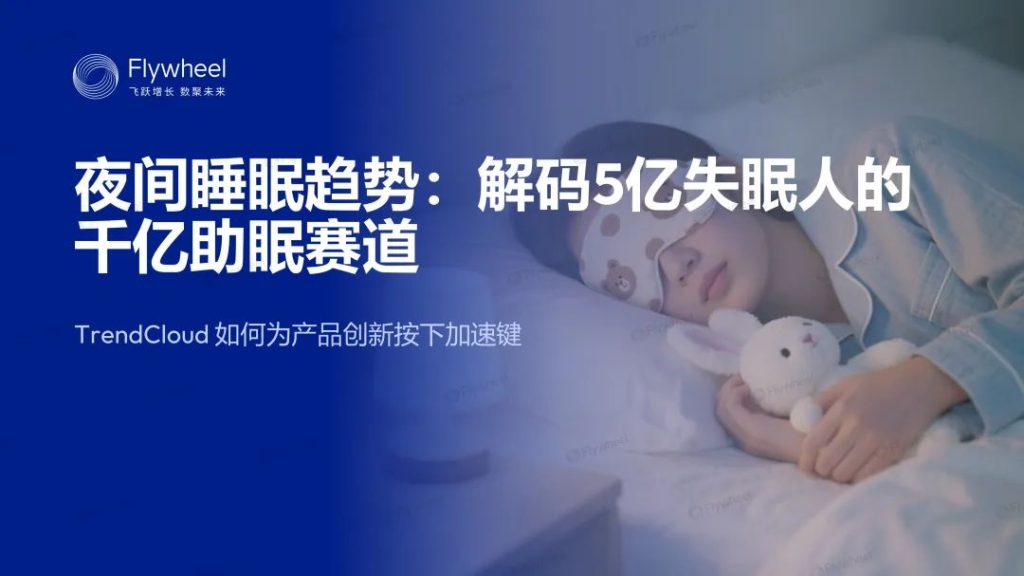
Read More《解码睡眠经济:当5亿“特困生”撑起千亿级新蓝海,品牌机会在哪里?》
Positive Reviews: The Rise of the Sleep Economy, and the Upgrade of Health Consumption Gives Birth to a New Blue Ocean Worth Billions
The explosive growth of the sleep economy is a typical microcosm of the awakening of health awareness and the upgrade of consumption in contemporary society. Judging from the data, the huge base of over 500 million insomniacs in China, the annual sales growth rate of 30% in the sleep – aid track, and the market expectation of exceeding one trillion by 2030 all confirm that this field has become the most potential “new blue ocean” in the consumer market. Its positive significance lies not only in the release of commercial value but also in promoting the popularization of a healthy lifestyle through product innovation and the satisfaction of needs.
Firstly, the rise of the sleep economy precisely echoes the people’s livelihood needs under the “Healthy China” strategy. With the implementation of policies such as the “Healthy Sleep Promotion Action Plan”, the public’s perception of the relationship between sleep and health has shifted from “being able to sleep” to “sleeping well”, and sleep quality has become an important indicator for measuring the quality of life. Data shows that 82% of consumers are willing to pay for emotional value, and “having a good sleep” has been given a new connotation of self – pleasing consumption. This transformation has promoted the extension of sleep – aid products from single functions (such as assisting in falling asleep) to “physical and mental healing”. For example, products like aroma sprays and intelligent sleep monitoring devices not only solve the problem of insomnia but also provide emotional relaxation through five – sense experiences (such as smell and touch), meeting the contemporary people’s pursuit of “ritual sense” and “happiness”.
Secondly, the precise operation of segmented groups and product innovation have injected continuous vitality into the market. The four core groups mentioned in the news, namely the “technology optimization group”, “high – pressure workplace people”, “delicate care group”, and “natural health preservation experts”, cover consumers of different ages, genders, and city levels. Their different needs (such as the technology group’s preference for intelligent monitoring and the delicate group’s emphasis on scene ritual sense) force brands to carry out refined product design. For example, the Deep Sleep Memory Pillow PRO of Atour Planet precisely hits the demand for “sleeping well” through its cool and comfortable experience and sleep posture optimization function, with sales exceeding 1.4 billion. The essential oil spray of Puyixiang meets the dual demands of “natural health preservation experts” for safety and science with its natural plant essential oil blending and authoritative certification (such as SGS), and its monthly sales exceed 3 million. These cases prove that differentiated innovation based on population portraits is the key for brands to break through in the red – ocean competition.
Finally, the prosperity of the sleep economy has promoted the integration of cross – field technologies and concepts. From traditional bedding (pillows, silk quilts) to 3C electronics (sleep headphones) and health supplements (wild jujube seed tea), sleep – aid products have formed a diversified category matrix. More notably, the formula for creating blockbuster products, “Five – sense experience = scientific principle × cross – functional efficacy”, integrates multi – dimensional technologies such as biotechnology (such as research on plant essential oil components), intelligent hardware (such as sleep monitoring algorithms), and traditional Chinese medicine theory (such as internal nourishment conditioning), endowing products with stronger technological barriers and user trust. For example, the popularity of wild jujube seed products has soared by 2055% due to the concept of “Chinese – style internal nourishment”, and the sales of sleep headphones have increased by 779% due to noise – reduction technology, both reflecting the deep binding of technology and demand. This cross – field innovation not only enhances the added value of products but also provides a replicable “methodology for creating blockbuster products” for the entire health – consumption industry.
Negative Reviews: Hidden Worries Behind the Prosperity, the Sleep Economy Needs to Beware of “False Fire” and “Misunderstandings”
Although the sleep economy has broad prospects, many problems have emerged during its rapid expansion. From consumer feedback to market competition, from product efficacy to health awareness, if these multiple hidden worries are not resolved in a timely manner, they may hinder the long – term healthy development of the industry.
Firstly, disputes over product efficacy and a trust crisis are gradually emerging. As mentioned in the news, 52.4% of consumers believe that sleep – aid products “have weak actual effects and exaggerated publicity”, and 18% of users who have feedback on the efficacy give negative reviews. This data reveals the core contradiction in the industry: some brands over – package concepts (such as “improving sleep in 14 days”) in pursuit of short – term sales but lack rigorous efficacy verification, resulting in a gap between user experience and expectations. For example, the popularity of melatonin products has declined by 38% in 2025 due to the controversy of “feeling more tired after sleeping”, which is precisely the collapse of consumers’ trust in the “single – drug regulation” model. If brands continue to ignore efficacy verification (such as third – party testing and long – term user tracking), it may lead to the “bad money driving out the good” phenomenon and damage the reputation of the entire track.
Secondly, it is necessary to be vigilant about the homogeneous competition in the market and the proliferation of “false demands”. Although there is a wide variety of products in the current sleep – aid track, some products still remain in the stage of “following concepts blindly”. For example, some aromatherapy brands only use “sleep – aid” as a gimmick but do not design differentiated functions for the core pain points of insomniacs (such as anxiety and environmental interference); some intelligent devices only monitor sleep data but cannot provide effective improvement plans. This “innovation for the sake of innovation” not only wastes market resources but also may make consumers doubt “technology – assisted sleep”. In addition, some merchants use “sleep anxiety” for marketing (such as “insomnia = health collapse”), packaging normal occasional insomnia as a “disease that must be treated” and inducing consumers to buy unnecessary products. This “anxiety – selling” behavior may increase the psychological burden on users.
Thirdly, consumers’ neglect of “fundamental sleep habits” may pose health risks. The causes of sleep problems are complex, involving multiple dimensions such as psychological stress, living habits, and environmental factors. However, some consumers rely too much on sleep – aid products (such as using aroma sprays and sleep – aid health products for a long time) but ignore basic measures such as adjusting work and rest (such as reducing caffeine intake) and improving the sleep environment (such as reducing noise). As mentioned in the news, 64.8% of insomniacs are troubled by drinking coffee or strong tea before going to bed, but most sleep – aid products do not provide solutions for such behavioral habits. If brands only focus on “product substitution” rather than “habit guidance”, it may lead users into a vicious cycle of “relying on products → decreasing effects → relying more on products”, which may actually aggravate sleep problems.
Suggestions for Entrepreneurs: Deeply Explore the Essence of Demands and Build Long – Term Value Driven by Both “Science” and “Experience”
Facing the opportunities and challenges of the sleep economy, entrepreneurs need to break away from the “quick – money – making” mindset, take user needs as the core, and build differentiated competitiveness. The following are specific suggestions:
Focus on Precise Population Insights and Avoid the Trap of “False Demands”:
Based on the four core groups mentioned in the news (the technology optimization group, high – pressure workplace people, etc.), use AI data tools (such as the TrendCloud platform) to deeply analyze their behavioral habits, consumption scenarios, and unmet pain points. For example, for the “high – pressure workplace people”‘s demand for “energy recovery after staying up late”, a compound product combining “sleep – aid and refreshing” can be developed (such as a daytime refreshing spray containing caffeine + a night – time sleep – aid aromatherapy set); for the “delicate care group”‘s demand for “bedtime ritual sense”, a “scenario – based sleep – aid gift box” (including aromatherapy, eye masks, and soothing music cards) can be designed. It should be noted that population segmentation needs to be combined with dynamic variables such as region and age (for example, consumers in third – tier cities are more price – sensitive) to avoid a one – size – fits – all approach.Strengthen Scientific Efficacy Verification and Build a Moat of User Trust:
Product publicity should be supported by rigorous scientific evidence to avoid exaggerating efficacy. For example, the Puyixiang spray has been certified by SGS for “improving sleep in 14 – 28 days”, and the Atour pillow is backed by the principle of “body temperature rhythm regulation”, which are both worthy of reference. Entrepreneurs can cooperate with scientific research institutions (such as sleep medicine laboratories) to conduct clinical tests or collect evidence through long – term user tracking (such as comparing 30 – day sleep data) and present the results in a visual form (such as data reports and user cases) to enhance credibility. At the same time, it is necessary to clearly mark the applicable population and limitations of the product (such as “assisting in improvement” rather than “treating insomnia”) to avoid misleading consumers.Build a Dual – Driven Model of “Experience + Efficacy” to Enhance the Added Value of Products:
The core competitiveness of sleep – aid products lies in the balance between “instant experience” and “long – term effects”. On the one hand, provide instant pleasure through five – sense design (such as a pillow with a comfortable touch and a soothing aroma) to lower the user’s trial – and – error threshold; on the other hand, ensure long – term improvement effects through technological innovation (such as algorithm optimization of intelligent monitoring devices and the upgrade of the efficacy of natural ingredients). For example, a “smart sleep butler” product can be developed, which combines hardware (sleep monitoring belt) and software (personalized sleep plan), providing both instant comfort experience (such as automatically adjusting the pillow height) and long – term effect feedback through data tracking (such as an increase in deep – sleep time).Promote Health Education and Guide Users to Establish a Scientific Sleep Concept:
Entrepreneurs need to assume the social responsibility of “sleep science popularization” and help users understand the multiple causes of insomnia (such as behavioral habits and psychological factors) through content marketing (such as science – popularization short videos and expert live broadcasts), and provide comprehensive solutions of “products + habit adjustment”. For example, when selling sleep – aid aromatherapy, a “guide to behaviors two hours before bedtime” (such as avoiding blue light and reducing caffeine intake) can be give; when promoting intelligent monitoring devices, a “course on improving sleep quality” can be provided simultaneously. By educating users, not only can brand favorability be enhanced, but also negative feedback caused by “over – relying on products” can be reduced, promoting the industry’s upgrade from “selling products” to “selling a healthy lifestyle”.
The essence of the sleep economy is a deep response to the needs of “people”. Entrepreneurs need to take users as the center and find a balance between commercial value and social value in order to sail steadily and far in the blue ocean worth billions.
创业时评《解码睡眠经济:当5亿“特困生”撑起千亿级新蓝海,品牌机会在哪里?》
- Startup Commentary”Building LLMs: The Knowledge Graph Foundation Every AI Project Needs”
- Startup Commentary”The 17th Year of Tmall Double 11 and the New Map Rewritten by AI”
- Startup Commentary”How to Prepare Your Data for Artificial Intelligence”
- Startup Commentary”Small and Medium-sized Banks: “Cutting the Tail” in Loan Assistance”
- Startup Commentary”The Six AI Giants on Stage: AGI Is No Longer a “Future” Thing”




